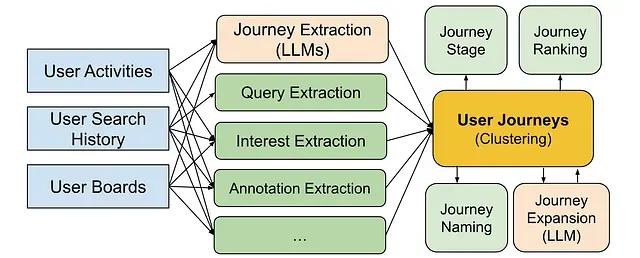Pinterest has outlined its newest method to content material suggestions, which makes use of AI evaluation of consumer behaviors to find out their probably intent in utilizing Pinterest.
The method goals to find out every consumer’s “journey,” as in what they’re really seeking to obtain by way of their Pin discovery and motion course of.
As defined by Pinterest:
“A consumer journey is a sequence of user-item interactions, typically spanning a number of classes, that facilities on a specific curiosity and divulges a transparent intent — equivalent to exploring tendencies or making a purchase order. For instance, a journey would possibly contain an curiosity in ‘summer time attire,’ an intent to ‘be taught what’s in fashion,’ and a context of being ‘prepared to purchase.’ Customers can have a number of, typically overlapping, journeys occurring concurrently as their pursuits and targets evolve.”
So Pinterest is seeking to broaden its suggestions past associated Pins to what every consumer is prone to be on the lookout for subsequent inside every journey, based mostly on different customers’ behaviors, in addition to the complete scope of every individual’s exercise.
And it’s working. By means of this up to date suggestions method, Pinterest has improved e mail click on price by 88%, whereas consumer surveys have proven 23% extra optimistic suggestions.
The method basically makes use of a wider breadth of alerts to know the probably purpose of every consumer, versus extra direct suggestions.
“By figuring out consumer journeys, we will transfer from easy content material suggestions to turning into a platform that assists customers in reaching their targets, whether or not it’s planning a marriage, renovating a kitchen, or studying a brand new ability.”

As you’ll be able to see on this diagram, the method makes use of a stepped course of to higher perceive the directional intent of every consumer’s exercise, and incorporates AI predictions inside the mannequin to map and title widespread journeys.
The primary indicators, as you’ll be able to see, are:
- Person search historical past: Aggregated queries and timestamps.
- Person exercise historical past: Interactions like Pin closeups, repins, and clickthroughs, extract the annotations and pursuits from the engaged Pins.
- Person’s boards: Extract the annotations and pursuits from the Pins within the consumer’s boards.
Based mostly on these components, the system makes use of clustering to generate key phrase clusters, with every cluster being a “journey candidate.”
“We then construct specialised fashions for journey rating, stage prediction, naming, and enlargement. This inference pipeline runs on a streaming system, permitting us to run full inference if there’s algorithm change, or every day incremental inference for current energetic customers so the journeys reply rapidly to a consumer’s most up-to-date actions.”
In order the customers’ conduct modifications, the journey prediction mannequin evolves, with LLMs then employed to generate new journey suggestions “based mostly on a consumer’s previous or ongoing journeys.”
That then drives Pinterest’s e mail push suggestions, prompting customers to return to the platform to proceed their journeys as predicted by the mannequin.
And that’s led to vital enhancements in e mail response.
It could appear considerably apparent in some respects, in predicting probably consumer conduct based mostly on their exercise, and mapping that in opposition to probably discovery paths. Nevertheless it’s a big evolution of predictive fashions on this respect, because the system appears to be like to anticipate what you’ll wish to see subsequent, based mostly on AI evaluation of your path.
It’s an fascinating improvement inside Pinterest’s broader development, which reveals how platforms could make higher use of AI inside their predictive fashions to reinforce the consumer expertise.
You’ll be able to examine Pinterest’s predictive journey modeling right here.



